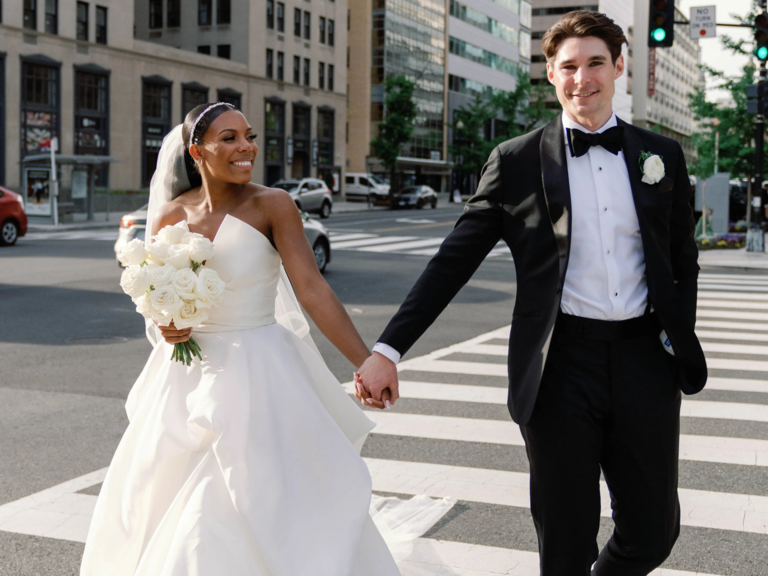The Complete Guide to Combining Last Names After Marriage

Marriage is about blending two lives into one, and for many couples, that includes a shared last name that reflects their partnership. While the tradition of one partner taking the other's last name is still common, many modern couples are exploring alternatives, like combining last names to form a completely new one. This innovative approach allows couples to celebrate their union in a unique and meaningful way. If you've been wondering about combining last names and how to go about it, this guide will walk you through everything you need to know.
In this article:
- Can You Combine Last Names When You Get Married?
- Why Are Couples Combining Last Names?
- Why Shouldn't You Combine Your Last Names?
- How Can You Combine Last Names When You Get Married?
Can You Combine Last Names When You Get Married?
Yes, you can absolutely combine last names when you get married! Instead of hyphenating or choosing one partner's name, this idea involves merging parts of both last names to create an entirely new surname. For example, if your last names are Taylor and Johnson, you might combine them into something like Tayson or Johnlor.
The legality of combining last names depends on where you live. In many places, this process is allowed but may require additional paperwork. You'll need to file a petition with the court to change your name after marriage and, in some cases, publish your intent to change your name in a local newspaper. Be sure to check your local laws and requirements before proceeding.
Combining last names is an increasingly popular choice among couples who want a fresh start together and prefer something that feels equally representative of both partners.
Why Are Couples Combining Last Names?
Choosing to combine two names offers couples a way to embrace equality, creativity and individuality in their marriage. Here are a few reasons why this trend is gaining traction.
A New Way to Symbolize Partnership
Mixing two names to make one is an opportunity for couples to celebrate their partnership. It also highlights each person's equal contributions to the relationship.
A Way to Honor Both Families
For many couples, it can feel unfair to leave one family's name behind. By combining last names, you're honoring both families equally and creating a new legacy together.
An Easy Way to Avoid Hyphenation
While hyphenated last names are popular, they can sometimes feel cumbersome or overly long. Combining last names simplifies things while still blending both partners' identities.
A Fun Way of Expressing Creativity
Blending two names together offers newlyweds the chance to be inventive. Whether you merge syllables, letters or even create something entirely new, it's an opportunity to let your creativity as a couple shine.
Why Shouldn't You Combine Your Last Names?
While combining last names has advantages, it may not be the right choice for everyone. Here are some potential drawbacks to consider:
Legal Complications
The process of combining last names can be more complex than simply adopting one partner's name. You may need to go through a legal name change process, which can involve court filings, fees and additional steps like publishing your new name in a local newspaper. Whereas a simple marriage name change typically only involves using your ID and marriage certificate as proof to update your last name.
Family Resistance
Some family members may have strong feelings about preserving a traditional last name or the loss of a maiden name. If this is the case, combining last names could lead to tension or disappointment from one or both families.
Potential Confusion
A newly created last name may confuse others, especially if it's very different from either original name. This could lead to questions or challenges when dealing with official documents or introductions.
How Can You Combine Last Names When You Get Married?
Combining last names is a multi-step process that requires careful planning and execution. Here's how to go about it.
Get Creative
Start by brainstorming how you'd like to combine your last names. Consider all the ways to mix and match to form something entirely new. Write down a few options and see which feels right for both of you. Here are some additional tips to combine two last names.
- Think Long-Term: Choose a name that feels meaningful and timeless to both of you.
- Consider Pronunciation: Make sure the new name is easy to pronounce and spell to avoid future frustrations.
- Consult an Expert: If you're unsure about the legal process or your options, consider speaking with a lawyer who specializes in name changes.
Research the Legal Requirements
Check the legal requirements for name changes in your state or county. Some places allow for combined last names as part of the marriage license process, while others require a separate court petition. Be prepared to submit forms, pay fees or possibly attend a hearing.
File the Paperwork
If your state requires it, file a name change petition with the court. This typically involves filling out a form, providing proof of identity and marriage and paying a fee. In some cases, you may also need to publish your intent to change your name in a local newspaper.
Update Your Personal Records
As with any marriage-related name change, once your new last name is legally recognized, you'll need to update all your personal records. This includes your Social Security card, driver's license, passport, bank accounts and any other official documents. Make a checklist to ensure you don't miss anything.
Inform Friends and Family
Let your loved ones know about your new last name. You can share the news in a creative way, such as including it in your wedding announcements or sending out a fun email to friends and family.























